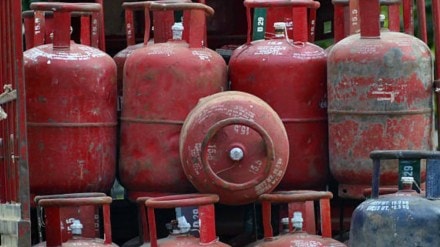The government raised LPG prices by Rs 50 per cylinder last week and hiked excise duty on diesel and petrol by Rs 2 per litre as crude oil prices fell to $63-64 per barrel. The aim is to help the state-owned oil marketing companies (OMCs) offset the losses incurred due to subsidised gas prices, explains Banasree Purkayastha
How is the price of an LPG cylinder calculated?
Prices of Liquefied Petroleum Gas (LPG), also known as cooking gas, are calculated based on a formula known as import parity price (IPP). Since India meets most of its LPG demand via imports, the calculations as per the IPP are dependent on fluctuations in LPG prices in the international market, which in turn, are dependent on the price of its main raw material, crude oil. The IPP is benchmarked to the LPG price of Saudi Aramco, the world’s largest producer of LPG. The price thus calculated in US dollars is then converted to Indian rupees. To this price, is then added a host of components such as the Free on Board (FOB) price, ocean freight, insurance charges, customs duties, port dues, the costs of inland freight, marketing costs, oil company margins, bottling charges, dealer commission, and the Goods and Services Tax (GST). The final price thus calculated gives the retail selling price for non-subsidised cooking gas cylinders for consumers across different states. The price of LPG cylinders is revised on a monthly basis.
Why has the government hiked prices now?
On April 8, the government increased the price of domestic LPG by Rs 50 for every cylinder. With this, price of a non-subsidised gas cylinder of 14.2 kg has increased to Rs 853 in Delhi, Rs 852 in Mumbai and Rs 868 in Chennai. The hike also applies to Pradhan Mantri Ujjwala Yojana (PMUY) beneficiaries.
Petroleum minister Hardeep Singh Puri has said the price hike, which comes after almost a year, is part of periodic reviews conducted to align with global fuel market trends and offset rising import costs. The hike will provide support to the profitability of the three state-owned OMCs — Hindustan Petroleum Corporation Ltd, Bharat Petroleum Corporation Ltd and Indian Oil Corporation Ltd — which were suffering massive under-recoveries of nearly Rs 43,000 crore on the sale of domestic LPG. The reduction in under-recoveries due to the price hike is estimated at Rs 10,000 crore for FY25-26.
How excise duty hike will also help OMCs
The government has also increased excise duties on petrol and diesel by Rs 2/litre. Puri has said the excise duty hikes were aimed at compensating oil marketing companies (OMCs) for selling LPG cylinders at a loss, in spite of the steady increase in their prices over the last few years internationally. The increase in excise duty collections for FY25-26 owing to the hike is expected to be Rs 35,000 crore. “Owing to the significant decline in crude oil prices recently, the marketing margins of oil marketing companies are expected to remain healthy despite the excise duty increase. Crude oil prices have crashed to $63-65/barrel (bbl) now from above $77/bbl as on March 31 owing to growing fears of a global recession with retaliatory tariffs being announced by China. Additionally, the planned production increase by OPEC+ is also contributing to downward pressure on crude prices,” said Prashant Vasisht, senior vice-president and co-group head, Corporate Ratings, ICRA.
The burden of the subsidy bill
The three OMCs cumulatively had 32.89 crore active domestic LPG customers, served through 25,542 distributors, as of December 2024. Under the Pradhan Mantri Ujjwala Yojana (PMUY) scheme availed by 10.33 crore consumers, a Rs 300 subsidy is given via direct benefit transfer (DBT) on every 14.2 kg cylinder for up to 12 refills per annum (and proportionately pro-rated for 5 kg connections). Again, under the ‘Give It Up’ campaign, as of February 1, 2025, around 1.15 crore well-off customers have given up their subsidies.
With the deregulation of petrol and diesel prices, the fuel subsidy bill of the Union government has decreased substantially over the years. In FY23-24, the LPG subsidy bill of the government was Rs 12,240 crore (including DBT of Rs 1,460 crore). The revised budget estimate for FY 24-25 was Rs 15,700 crore (including DBT of Rs 500 crore). The Budget for FY 25-26 has estimated the LPG subsidy at Rs 11,100 crore (including DBT of Rs 1,500 crore).
Consumption & import trends
About 60-65% OF the domestic LPG demand is met through imports. LPG imports rose 10.3% y-o-y to 1.82 million tonne (mt) in January 2025. However, it fell by 2.2% on a monthly basis, as per the Petroleum Planning & Analysis Cell. LPG consumption had surged by 7% in 2024 due to a combination of low global prices, the general elections and increase in rural LPG consumption. In 2025, however, LPG import growth is likely to slow down as residential demand eases, with the policy shifting towards piped natural gas and biofuels as LPG penetration nears saturation, per a March 2025 report by maritime research consultancy Drewry. In 2024, the Middle East contributed 97% of India’s total LPG imports (Middle Eastern LPG is butane-dominated thus meeting India’s residential LPG need of 60: 40 butane-propane blend. If China competes for Middle East supplies given the ongoing tariff war with the US, it could lead to higher Saudi CP propane prices and a higher import bill for India.
